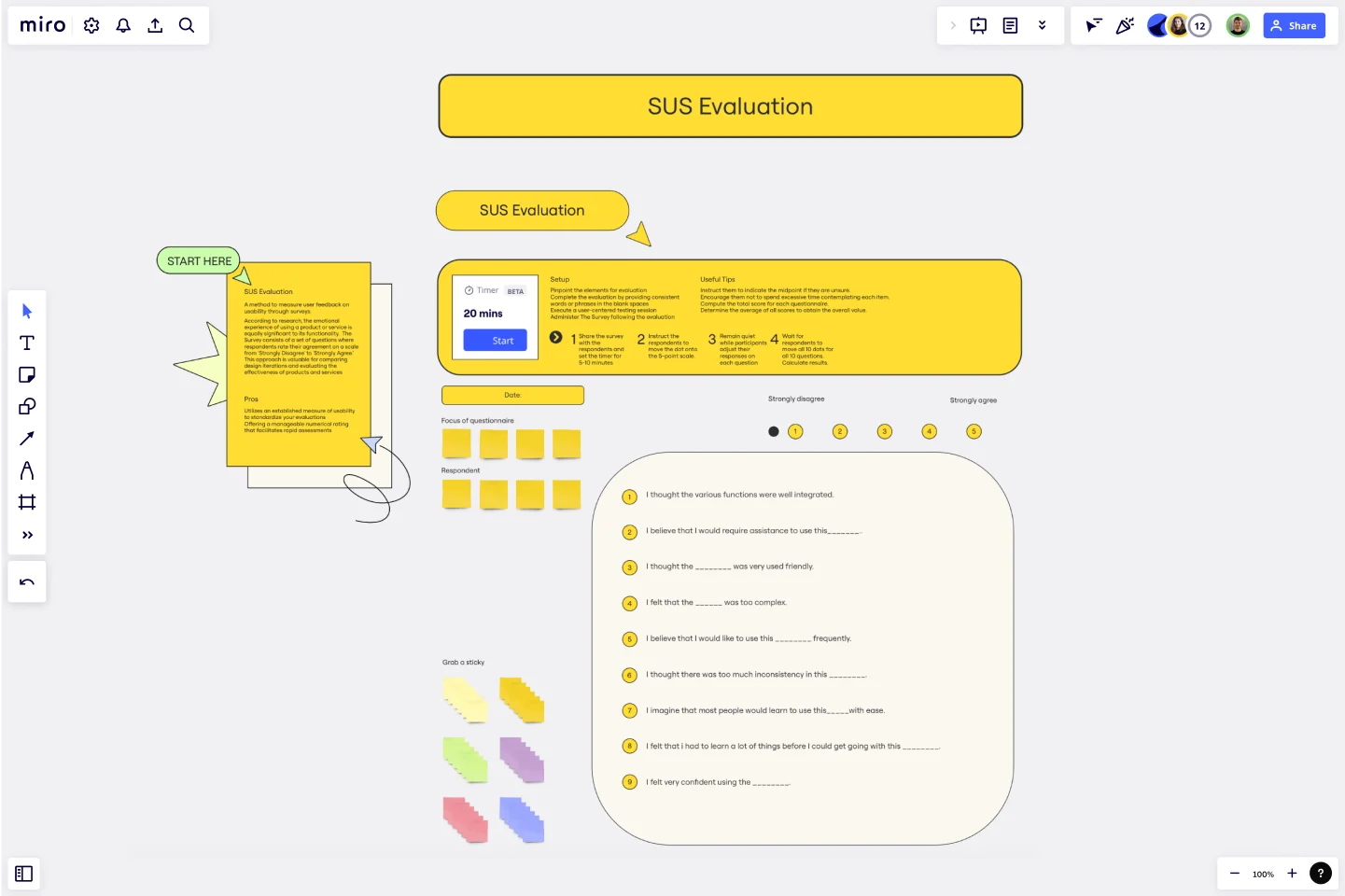SUS Evaluation
Measure user feedback on usability with the SUS Evaluation Template.
About the SUS Evaluation
In today's highly competitive market, it's not enough for a product or service to simply function well. Research has shown that the emotional experience of using a product or service is equally important as its functionality.
To measure this emotional experience, you can use the SUS Evaluation Template. This involves surveying with a set of questions where respondents rate their level of agreement on a scale ranging from 'Strongly Disagree' to 'Strongly Agree.' These questions evaluate various aspects of the user experience, such as ease of use, aesthetics, and overall satisfaction. This approach is valuable for comparing design iterations and evaluating the effectiveness of products and services.
Benefits of using the template
Use an established measure of usability to standardize your evaluations.
Offer a manageable numerical rating that facilitates rapid assessments.
How to use the template
Share the survey with the respondents and set the timer for 5-10 minutes.
Instruct the respondents to move the dot onto the 5-point scale.
Remain quiet while participants adjust their responses on each question.
Wait for respondents to move all 10 dots for all 10 questions. Calculate results.
Setup
Pinpoint the elements for evaluation.
Complete the evaluation by providing consistent words or phrases in the blank spaces.
Execute a user-centered testing session.
Administer The Survey following the evaluation.
Useful tips
Instruct them to indicate the midpoint if they are unsure.
Encourage them not to spend excessive time contemplating each item.
Compute the total score for each questionnaire.
Determine the average of all scores to obtain the overall value.
Get started with this template right now.
Proto Persona Template
Works best for:
UX, UX Research, Product Design
The Proto Persona Template is tailored to capture the essence of hypothetical user segments. It encapsulates key attributes such as user needs, behaviors, and potential pain points. One of its standout benefits is its ability to foster empathy. By visualizing and understanding these preliminary user profiles, design and strategy teams can tap into a deeper connection with their target audience, ensuring that solutions resonate authentically and address genuine needs.
Storyboard for Product Development Template
Works best for:
Storyboard
Plan your product’s journey from concept to market with the Storyboard for Product Development template. It outlines every stage of development, including ideation, research, design, testing, and launch. This template promotes clarity, resource planning, and effective communication across teams, making it perfect for product managers and developers who need a comprehensive roadmap to bring innovative ideas to life.
Analytics Storyboard
Works best for:
Planning, Storyboard, Design
Visualize your data insights with the Analytics Storyboard template. This tool is perfect for data analysts and business intelligence teams, helping you present complex data in a clear and engaging narrative format. It includes sections for data sources, key findings, and visualizations, ensuring your audience can easily understand and act on your insights. Use this template to create compelling data stories that drive informed decision-making and strategic planning.
Spider Chart Template
Works best for:
Design
Spider Charts (or star plots) prioritize thoughts and ideas by importance. They help visualize complex information with significant items in the center and less important items progressively farther from it. Radar spider charts help understand relationships between information for better decision-making.
Design Review Template
Works best for:
Design
Constructive feedback is a valuable skill. The Design Review Template provides a structured approach for effective conversations. Critiques promote collaboration and drive improvement, inspiring all participants. It's an accessible way to involve people beyond your core team.
Heuristic Evaluation Template
Works best for:
Design
The Heuristic Evaluation Template is a valuable tool in UX design. It relies on heuristics to identify usability issues and opportunities for improvement. Similarly, design heuristics serve as guidelines to evaluate the quality of a design solution. Following ten principles of good design can enhance the effectiveness of a product or service. Use these guidelines to evaluate your work and enhance the user experience of your design solutions.
